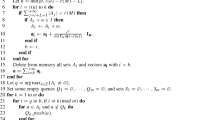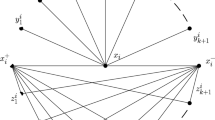Abstract
The Lovász ϑ-function (Lovász in IEEE Trans. Inf. Theory, 25:1–7, 1979) of a graph G=(V,E) can be defined as the maximum of the sum of the entries of a positive semidefinite matrix X, whose trace Tr(X) equals 1, and X ij =0 whenever {i,j}∈E. This function appears as a subroutine for many algorithms for graph problems such as maximum independent set and maximum clique. We apply Arora and Kale’s primal-dual method for SDP to design an algorithm to approximate the ϑ-function within an additive error of δ>0, which runs in time \(O(\frac{\vartheta ^{2} n^{2}}{\delta^{2}} \log n \cdot M_{e})\), where ϑ=ϑ(G) and M e =O(n 3) is the time for a matrix exponentiation operation. It follows that for perfect graphs G, our primal-dual method computes ϑ(G) exactly in time O(ϑ 2 n 5logn).
Moreover, our techniques generalize to the weighted Lovász ϑ-function, and both the maximum independent set weight and the maximum clique weight for vertex weighted perfect graphs can be approximated within a factor of (1+ϵ) in time O(ϵ −2 n 5logn).
Similar content being viewed by others
Notes
An odd hole is an induced C k for odd k, and an odd anti-hole is an induced \(\overline{C_{k}}\).
Throughout this paper, we use \(\tilde{O}(\cdot)\) to hide poly-logarithmic factor; formally, \(f(n) = \tilde{O}(g(n))\) if there exists k>0 such that f(n)=O(g(n)logk n).
In Arora and Kale’s description, it is suggested that the Oracle is run with a “candidate” primal solution \(\mathbf {X}:= \frac{\mathbf {W}}{\mathbf {Tr}(\mathbf {W})}\), but this is not entirely necessary, and we incorporate this rescaling operation in the Oracle itself to simplify the description. Moreover, in their description of the Oracle, the primal solution returned is always X itself. However, in their applications, the Oracle can also return a slightly modified version of X, in a manner which is more in accordance with our description.
According to Arora and Kale’s framework, it is sufficient to have z≤β. However, in our case, it is to our advantage for the Oracle to produce a dual solution with z=β.
We remind the reader here that the width ρ β of the Oracle depends on the candidate value β currently being tested.
References
Arora, S., Hazan, E., Kale, S.: The multiplicative weights update method: a meta-algorithm and applications. http://www.cs.princeton.edu/~ehazan/papers/MWsurvey.pdf
Arora, S., Hazan, E., Kale, S.: \({O}(\sqrt{\log n})\) approximation to sparsest cut in \(\tilde{O}(n^{2})\) time. In: Proceedings of the 45th Annual IEEE Symposium on Foundations of Computer Science, pp. 238–247 (2004)
Arora, S., Kale, S.: A combinatorial, primal-dual approach to semidefinite programs. In: Proceedings of the 39th Annual ACM Symposium on Theory of Computing, pp. 227–236 (2007)
Alizadeh, F.: Interior point methods in semidefinite programming with applications to combinatorial optimization. SIAM J. Optim. 5(1), 13–51 (1995)
Berge, C.: Färbung von Graphen, deren sämtliche bzw. deren ungerade Kreise starr sind. Wiss. Z., Martin-Luther-Univ. Halle-Wittenb., Math.-Nat.wiss. Reihe 10, 114 (1961)
Chudnovsky, M., Cornuéjols, G., Liu, X., Seymour, P., Vusković, K.: Recognizing |Berge graphs. Combinatorica 25, 143–186 (2005)
Chudnovsky, M., Robertson, N., Seymour, P., Thomas, R.: The strong perfect graph theorem. Ann. Math. 164, 51–229 (2006)
Eisenbrand, F., Funke, S., Garg, N., Könemann, J.: A combinatorial algorithm for computing a maximum independent set in a t-perfect graph. In: Proceedings of the Fourteenth Annual ACM-SIAM Symposium on Discrete Algorithms, pp. 517–522 (2003)
Garg, N., Könemann, J.: Faster and simpler algorithms for multicommodity flow and other fractional packing problems. In: Proceedings of the 39th Annual Symposium on Foundations of Computer Science, pp. 300–309 (1998)
Grotchel, L., Lovasz, L., Schrijver, A.: Polynomial algorithms for perfect graphs. In: Annals of Discrete Mathematics, pp. 325–356 (1984)
Grotchel, L., Lovasz, L., Schrijver, A.: Geometric Algorithms and Combinatorial Optimization. Springer, Berlin (1987)
Golumbic, M.C.: Algorithmic Graph Theory and Perfect Graphs. Academic Press, New York (1980)
Golub, G.H., van Loan, C.F.: Matrix Computations, 3rd edn. Johns Hopkins University Press, Baltimore (1996)
Iyengar, G., Phillips, D.J., Stein, C.: Approximating semidefinite packing programs. SIAM J. Optim. 21(1), 231–268 (2011)
Klein, P.N., Lu, H.-I.: Efficient approximation algorithms for semidefinite programs arising from max cut and coloring. In: Proceedings of the 28th Annual ACM Symposium on Theory of Computing, pp. 338–347 (1996)
Karger, D.R., Motwani, R., Sudan, M.: Approximate graph coloring by semidefinite programming. J. ACM 45(2), 246–265 (1998)
Knuth, D.E.: The sandwich theorem. Electron. J. Comb. 1 (1994)
Koufogiannakis, C., Young, N.E.: Beating simplex for fractional packing and covering linear programs. In: Proceedings of the 48th Annual IEEE Symposium on Foundations of Computer Science, pp. 494–504 (2007)
Lovász, L.: On the Shannon capacity of a graph. IEEE Trans. Inf. Theory 25, 1–7 (1979)
Nayakkankuppam, M.V., Overton, M.L.: Primal-dual interior-point methods for semidefinite programming: numerical experience with block-diagonal problems. In: Proceedings of the 1996 IEEE International Symposium on Computer-Aided Control System Design, pp. 235–239 (1996)
Pan, V.Y., Chen, Z.Q.: The complexity of the matrix eigenproblem. In: Proceedings of the Thirty-First Annual ACM Symposium on Theory of Computing, STOC ’99, pp. 507–516. ACM, New York (1999)
Plotkin, S.A., Shmoys, D.B., Tardos, É.: Fast approximation algorithms for fractional packing and covering problems. In: Proceedings of the 32nd Annual Symposium on Foundations of Computer Science, pp. 495–504 (1991)
Seymour, P.: How the proof of the strong perfect graph conjecture was found. Gaz. Math. 109, 69–83 (2006)
Shannon, C.E.: The zero-error capacity of a noisy channel. IRE Trans. Inf. Theory 2(3), 8–19 (1956)
Vazirani, V.V.: Primal-dual schema based approximation algorithms (abstract). In: Computing and Combinatorics, pp. 650–652 (1995)
vanden Eshof, J., Hochbruck, M.: Preconditioning Lanczos approximations to the matrix exponential. SIAM J. Sci. Comput. 27(4), 1438–1457 (2006)
Acknowledgement
We would like to thank Khaled Elbassioni for discussion at the initial stage of the project.
Author information
Authors and Affiliations
Corresponding author
Additional information
A preliminary version of the paper appeared in IEEE International Symposium on Information Theory 2009. This research was done while the authors were at Max-Planck-Institut für Informatik, 66123 Saarbrücken, Germany.
Rights and permissions
About this article
Cite this article
Chan, TH.H., Chang, K.L. & Raman, R. An SDP Primal-Dual Algorithm for Approximating the Lovász-Theta Function. Algorithmica 69, 605–618 (2014). https://doi.org/10.1007/s00453-013-9756-5
Received:
Accepted:
Published:
Issue Date:
DOI: https://doi.org/10.1007/s00453-013-9756-5




